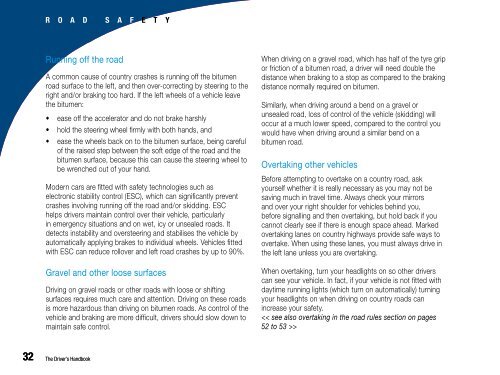the driver's handbook
the driver's handbook
the driver's handbook
- TAGS
- handbook
- 210.247.132.180
Create successful ePaper yourself
Turn your PDF publications into a flip-book with our unique Google optimized e-Paper software.
32<br />
R O A d S A f E t y<br />
Running off <strong>the</strong> road<br />
A common cause of country crashes is running off <strong>the</strong> bitumen<br />
road surface to <strong>the</strong> left, and <strong>the</strong>n over-correcting by steering to <strong>the</strong><br />
right and/or braking too hard. If <strong>the</strong> left wheels of a vehicle leave<br />
<strong>the</strong> bitumen:<br />
• ease off <strong>the</strong> accelerator and do not brake harshly<br />
• hold <strong>the</strong> steering wheel firmly with both hands, and<br />
• ease <strong>the</strong> wheels back on to <strong>the</strong> bitumen surface, being careful<br />
of <strong>the</strong> raised step between <strong>the</strong> soft edge of <strong>the</strong> road and <strong>the</strong><br />
bitumen surface, because this can cause <strong>the</strong> steering wheel to<br />
be wrenched out of your hand.<br />
Modern cars are fitted with safety technologies such as<br />
electronic stability control (ESC), which can significantly prevent<br />
crashes involving running off <strong>the</strong> road and/or skidding. ESC<br />
helps drivers maintain control over <strong>the</strong>ir vehicle, particularly<br />
in emergency situations and on wet, icy or unsealed roads. It<br />
detects instability and oversteering and stabilises <strong>the</strong> vehicle by<br />
automatically applying brakes to individual wheels. Vehicles fitted<br />
with ESC can reduce rollover and left road crashes by up to 90%.<br />
Gravel and o<strong>the</strong>r loose surfaces<br />
Driving on gravel roads or o<strong>the</strong>r roads with loose or shifting<br />
surfaces requires much care and attention. Driving on <strong>the</strong>se roads<br />
is more hazardous than driving on bitumen roads. As control of <strong>the</strong><br />
vehicle and braking are more difficult, drivers should slow down to<br />
maintain safe control.<br />
The Driver’s Handbook<br />
When driving on a gravel road, which has half of <strong>the</strong> tyre grip<br />
or friction of a bitumen road, a driver will need double <strong>the</strong><br />
distance when braking to a stop as compared to <strong>the</strong> braking<br />
distance normally required on bitumen.<br />
Similarly, when driving around a bend on a gravel or<br />
unsealed road, loss of control of <strong>the</strong> vehicle (skidding) will<br />
occur at a much lower speed, compared to <strong>the</strong> control you<br />
would have when driving around a similar bend on a<br />
bitumen road.<br />
Overtaking o<strong>the</strong>r vehicles<br />
Before attempting to overtake on a country road, ask<br />
yourself whe<strong>the</strong>r it is really necessary as you may not be<br />
saving much in travel time. Always check your mirrors<br />
and over your right shoulder for vehicles behind you,<br />
before signalling and <strong>the</strong>n overtaking, but hold back if you<br />
cannot clearly see if <strong>the</strong>re is enough space ahead. Marked<br />
overtaking lanes on country highways provide safe ways to<br />
overtake. When using <strong>the</strong>se lanes, you must always drive in<br />
<strong>the</strong> left lane unless you are overtaking.<br />
When overtaking, turn your headlights on so o<strong>the</strong>r drivers<br />
can see your vehicle. In fact, if your vehicle is not fitted with<br />
daytime running lights (which turn on automatically) turning<br />
your headlights on when driving on country roads can<br />
increase your safety.<br />
>


